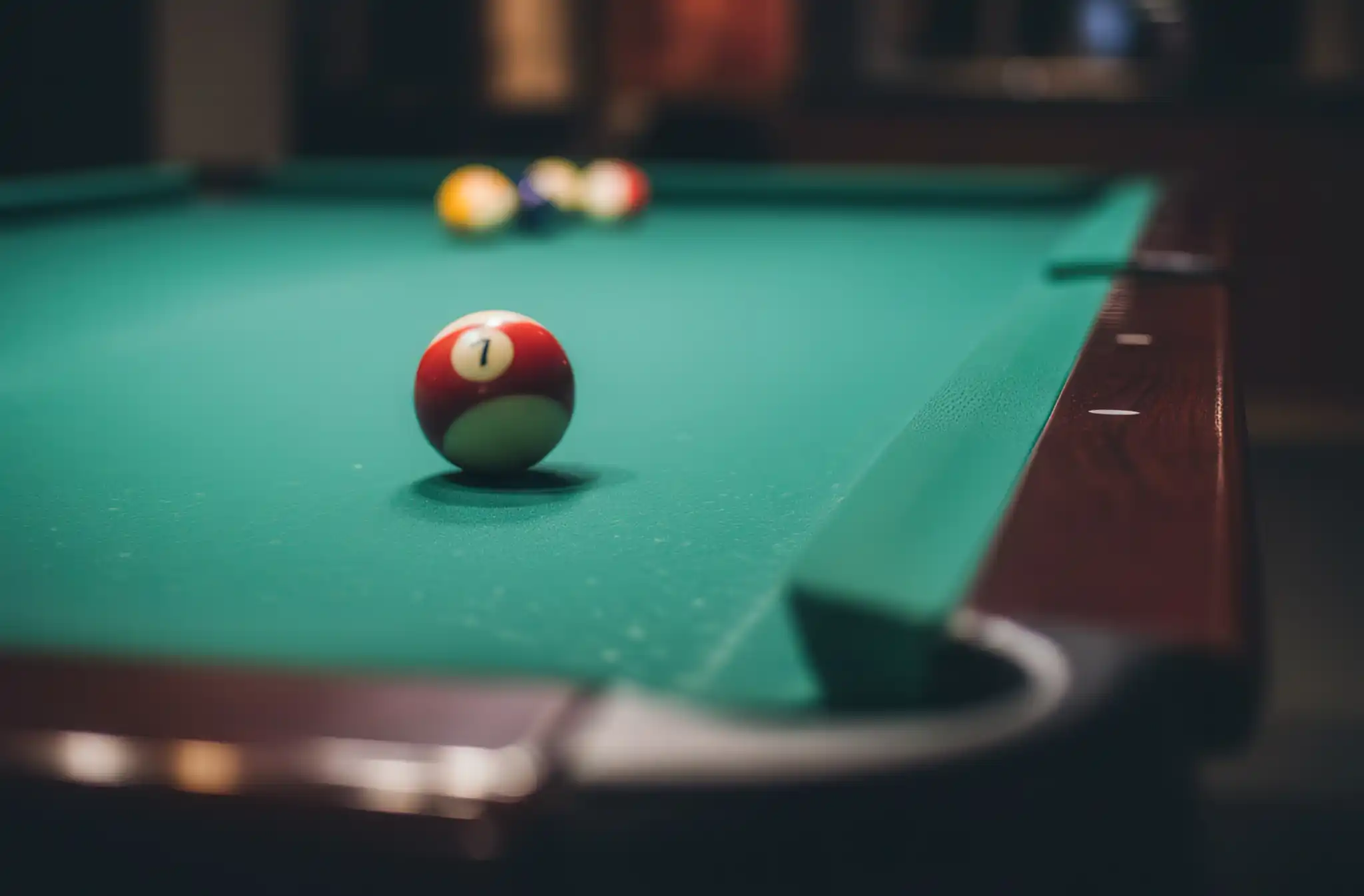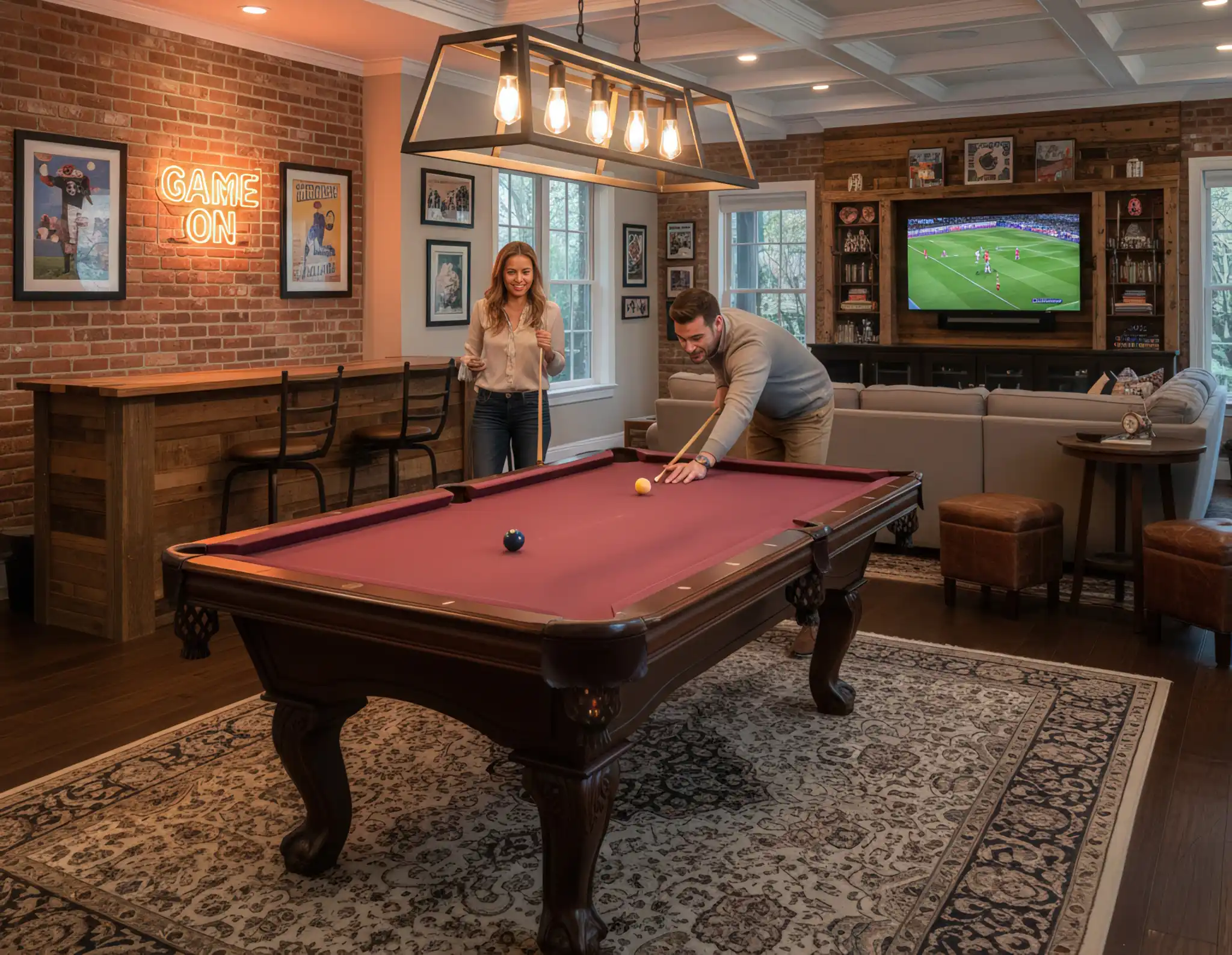There is nothing more frustrating for a pool enthusiast than watching a perfectly aimed shot slowly, inexplicably drift off line. That slight, maddening curve of the ball is a tell-tale sign that your playing surface is unlevel. An uneven table compromises every game, turning a sport of precision into a game of chance. Many homeowners in the GTA have invested in a premium table. For them, settling for anything less than perfect play is not an option.
This guide provides a definitive, step-by-step process for leveling your pool table. We will cover how to diagnose the problem and the essential tools you’ll need. We’ll also review the professional method for achieving a tournament-ready surface. We’ll also share expert tips for Brunswick and Olhausen owners. This will help you decide if a DIY adjustment is feasible. We’ll also explain when to call a professional to protect your investment.
Key Takeaways
- A carpenter’s level or smartphone app is not precise enough for a pool table; a machinist’s level is the non-negotiable tool for accurate results.
- True, professional leveling involves shimming the slate itself to be perfectly coplanar, not just adjusting the table legs.
- DIY attempts on 3-piece slate tables carry a significant risk of cracking the slate or creating high spots, leading to permanent damage.
- Older homes in Toronto and the GTA often have uneven floors, which require professional expertise to counteract persistent settling issues.
- Premium brands like Brunswick and Olhausen feature unique construction, and using a certified technician protects your warranty and your investment.
Is Your Pool Table Really Unlevel? 3 Signs to Look For
Before you break out the tools, it’s crucial to confirm that your table is the source of the problem. Here are three simple signs to look for.
Sign 1: The Obvious Roll-Off Test
This is the most common test. Place a billiard ball in the exact center of your table. If the ball consistently rolls in one direction, your table is unlevel. You can also place the ball on the head spot and foot spot to see if the roll is consistent across the entire surface. A true-level table will hold the ball stationary.

Sign 2: Inconsistent Ball Behaviour Near the Rails
Pay close attention to how a ball behaves when it’s rolling parallel to a rail. Does it drift away from the cushion or curve into it? Test this on all four rails. Inconsistency here often points to a dip or a warp in the table’s foundation, indicating a leveling issue.
Sign 3: Listening for Creaks and Settlement Noises
A pool table is incredibly heavy. Over time, especially on carpet or in older homes with settling foundations, the frame can settle unevenly. If you hear creaking or popping sounds when you lean gently on the table (do not sit on it!), it can be a sign that the frame is under stress and no longer evenly supported. This is a clear indicator that it’s time for a re-level.
The Pro Toolkit: Gathering Your Supplies
Using the wrong tools is the number one reason DIY leveling attempts fail. A pool table is a piece of precision equipment, and it demands precision instruments.
Essential Tools: What You Absolutely Need (Machinist’s Level, Wrenches)
Forget the carpenter’s level you have in the garage. The bubble vial on a standard level is not sensitive enough. It cannot detect the minute variations that send a ball off course. This instrument provides much higher accuracy, often to within fractions of a millimeter. It is the professional standard. You will also need a set of wrenches or sockets that fit the leg bolts on your specific table model.
Recommended Extras: Making the Job Easier (Shims, Pry Bar)
For a professional job, you will need shims. These are thin, tapered pieces of wood or plastic used for making micro-adjustments. It’s best to have both wood (for under the legs) and plastic shims (which are ideal for shimming the slate). A small, rubber-coated pry bar can be helpful if you need to gently lift a corner of the slate, but you should do this with extreme caution.
A Note on Using Your Smartphone: Why a Real Level is Better
It can be tempting to download a “level” app on your smartphone, but this is a critical mistake. These apps rely on the phone’s internal sensors. Manufacturers do not calibrate them for this level of precision. They also lack the necessary physical span; a level’s accuracy is dependent on its length. A 6-inch phone cannot accurately measure the plane of an 8-foot or 9-foot table. Using an app will only lead to frustration and a table that is still unlevel.
The 4-Step Professional Leveling Method
This is the core process that professional installers use. While leg adjustments are part of it, the critical work happens at the slate.
Step 1: The Initial Assessment with a Machinist’s Level
First, you may need to remove the felt if you are doing a full re-installation. For a table that is already set up, you can work directly on the playing surface. Place your machinist’s level on the slate or felt, lengthwise down the center of the table. Note the reading. Then, place it widthwise across the center. Finally, check the level lengthwise and widthwise near all four rails. This gives you a complete “map” of the unlevel areas.
Step 2: Foundation First – Adjusting the Table Legs
Start with the foundation. Using your wrench, adjust the built-in levelers on the table legs. If your table doesn’t have them, you will need to use wooden shims under the legs. Work your way around the table, making small adjustments to get the table “close” to level. This is just the first step. Getting the frame level is important, but the playing surface itself is the ultimate goal.
Step 3: The Critical Step – Shimming the Slate (with video embed)
This is the step that separates amateurs from professionals. Most high-quality tables use a 3-piece slate system. True leveling requires making these three pieces perfectly flat and seamless (coplanar). Professionals do this by placing shims between the slate and the table frame.
This process often requires at least two people. You may need to loosen the slate screws. Gently use a pry bar to create a tiny gap. Then, slide a thin plastic shim into place to raise a low spot. This is high-stakes work. If you overtighten the slate screws or pry improperly, you can crack the brittle slate. This is a costly and irreversible mistake. This is why most DIY guides fail—they skip this essential, high-risk step entirely.
Step 4: The Final Check and Fine-Tuning
Once you believe the slate is perfectly level, go back to Step 1. Re-check every area of the table with your machinist’s level. Roll a ball across different paths to see if there is any deviation. Be prepared to make several micro-adjustments, either to the leg levelers or the slate shims, until the level is perfect and the ball rolls true in every direction.
Expert Tips for Brunswick and Olhausen Owners
As the exclusive authorized Brunswick dealer in the GTA, we know that premium tables are not generic. They are engineered systems, and servicing them requires brand-specific knowledge.
Leveling Your Brunswick Table: What to Know About their Slate System
Brunswick tables are famous for their construction. Many models feature patented leveling systems and specific slate-to-frame construction. Using generic advice found online can be risky. Our certified technicians receive factory training on these proprietary systems. We understand how to level a Brunswick to its exact manufacturer specifications. This ensures optimal play and protects your warranty.
Leveling Your Olhausen Table: Adjusting the Accu-Fast Cushions
Olhausen tables, famous for their Accu-Fast cushions and exceptional build quality, also have unique construction. The table’s level has a direct effect on the responsiveness and angle of the cushions. A table that is “almost” level can make rails play inconsistently. Our technicians have decades of experience with Olhausen’s specific designs. We ensure both the slate and the cushions perform as one perfect system.
DIY vs. Calling a Pro: A Decision Guide for GTA Homeowners
Knowing your limits is key. A failed DIY attempt can be far more costly than a professional service call.
Do It Yourself vs. Calling A Professional: A Comparison
| Attempt a DIY Adjustment IF… | Immediately Call a Professional IF… |
| The issue is minor and you’re making small adjustments. | You own a premium 3-piece slate table (Brunswick, Olhausen, or antique). |
| You own a newer table. | You suspect the slate seams are uneven or the slate has a dip. |
| You have invested in a proper machinist’s level. | You live in an older Toronto home with uneven basement or main floors. |
| You’ve confirmed the problem is a simple leg settling on carpet. | You only have a carpenter’s level or a smartphone app. |
| The ball rolls consistently in one direction (vs. erratically). | You are not comfortable with the risk of cracking the (costly) slate. |
What to Expect from a Hallmark Billiards Leveling Service
When you call us, you are booking peace of mind. Our white-Glove service includes a visit from a certified, insured technician with decades of experience. They arrive with a precision machinist’s level (often costing over $150). They have the expertise to properly shim the slate without risking damage. We understand the specific engineering of your brand and the unique challenges of GTA homes. We guarantee a perfectly level, tournament-ready playing surface.
Book Your Professional Pool Table Leveling Service Today
Don’t risk your investment or settle for a compromised game. A perfectly level table is the heart of any great game room. Our certified technicians are ready to provide the precision, white-glove service your table deserves.
For professional peace of mind and the guarantee of perfect play, contact Hallmark Billiards today to schedule your leveling service in the GTA.
Conclusion
Identifying an unlevel pool table is the easy part. Actually fixing it, however, reveals the difference between a simple adjustment and a professional, precision task. A minor leg adjustment might be tempting. But true leveling lives in the meticulous shimming of the slate. This is a process that requires a machinist’s level and an expert’s hand. For owners of premium tables in the GTA, protecting your table is a must. This is especially true in older homes with uneven floors. Professional leveling isn’t just a service. It’s an investment to protect your table. It ensures every game is played exactly as it was meant to be.
For professional pool table services in the Greater Toronto Area, contact Hallmark Billiards today.





